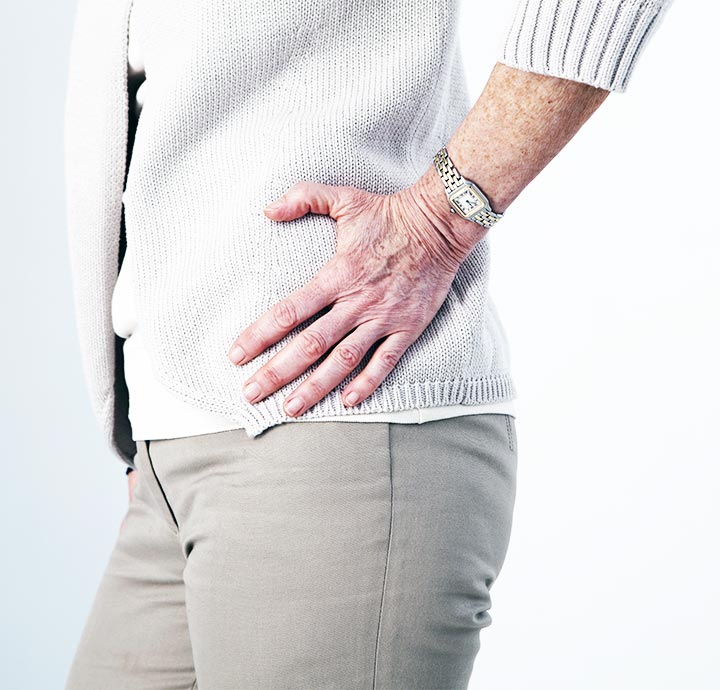
Hip pain is any kind of physical discomfort or pain felt in the hip area. Hip pain may be concentrated in the hip or in the area around the hip joint.
The hip is the body’s largest ball-and-socket joint. It allows for a wide range of motion while providing balance and stability needed for the body to bare weight.
It’s common for hip issues to cause pain in neighboring areas rather than in the hip itself. Pain associated with the hip may be felt in the thigh, groin or buttocks. Some types of hip pain aren’t actually caused by issues with the hip joint itself. In some cases, the source of the pain is in the soft tissues that surround the hip joint, including tendons, muscles and ligaments.
When there are issues with the hip joint, the pain is usually concentrated inside of the hip or the groin. If the pain is due to a problem with the surrounding soft tissues, the pain is typically felt elsewhere, like the outside of the buttocks or hips, or in the upper area of the thigh. Issues with other areas of the body, such as the back, can also trigger pain in the hip area.
There are many potential causes of hip pain. Some of the most common causes include:
- Arthritis — Certain types of arthritis, most notably osteoarthritis and rheumatoid arthritis, can lead to hip pain due to cartilage breakdown. Cartilage acts as a buffer between the ball and socket, allowing for smooth movement. When cartilage breaks down, the joint becomes less efficient. With advanced stages of osteoarthritis and rheumatoid arthritis, there may be very little to no cartilage, causing bones to rub directly against one another.
- Bursitis — Hip pain may be the result of bursitis, which is inflammation of the bursae. Bursae are fluid-filled sacs within the joints that provide cushioning and protection against friction.
- Hip fractures — Fractures of the hip typically trigger pain in the hip and groin area. The pain is usually intense and occurs immediately following the fracture. Hip fractures require prompt medical attention.
- Tendinitis — There are various tendons that attach muscles to the bones of the hip. When one or more of these tendons becomes inflamed, the result is tendinitis. This condition, which is also called hip flexor tendinitis, can cause pain and inflammation in the hip area.
- Labral tear in the hip — The labrum is a piece of cartilage that provides stability during hip joint movement. Hip pain can occur when there’s a tear in the labrum due to injury or overuse.
- Hip impingement — With hip impingement, the ball and socket of the hip joint don’t fit together as they should, preventing the smooth gliding motion associated with this type of joint. Hip impingement can lead to painful friction.
It’s important to see your doctor right away if you experience sudden and severe hip pain from some sort of physical trauma, for example a fall or car accident. Some hip injuries require immediate medical treatment. Also see your doctor if your pain is persistent and interferes with daily life.
Pain from minor hip issues may be manageable with conservative home remedies, including:
- Rest — If your hip pain is caused by an injury or overuse, you may need to restrict your movements for a period of time and allow the hip area to rest. Avoid putting pressure on a painful hip. Try sleeping on the other side to alleviate discomfort. It’s also important to avoid sitting for long periods since prolonged sitting can trigger hip pain.
- OTC pain relievers — Over-the-counter medications like ibuprofen and naproxen can provide both pain relief and anti-inflammation benefits.
- Cold therapy — Icing the hip area can help relieve discomfort and inflammation. You can ice up to 20 minutes at a time, three or four times a day.
- Low-impact exercise — To keep the muscles surrounding your hip strong while reducing stress, choose low-impact sports like cycling and swimming. Consider avoiding high-impact sports like running until your pain goes away.
- Strength training — Strengthening the muscles that support the hip joint can reduce discomfort. A physical therapist can put together an exercise routine geared at strengthening muscles while reducing stress to the hip area.
- Stretching exercises — Regular stretching can help improve flexibility and range of motion, easing tight muscles that can lead to hip pain.
- Orthotics — Wearing orthotics with your shoes can help improve alignment and reduce stress on painful hips. Dr. Scholl’s® Pain Relief Orthotics for Arthritis Pain are designed specifically for people suffering from arthritis pain, including arthritis hip pain.
More serious hip conditions and injuries may require extensive treatments, including prescription medication, injections and surgery.
SOURCES
https://www.pennmedicine.org/for-patients-and-visitors/patient-information/conditions-treated-a-to-z/hip-pain
https://www.webmd.com/pain-management/guide/hip-pain-causes-and-treatment
https://www.mayoclinic.org/symptoms/hip-pain/basics/definition/sym-20050684
https://orthoinfo.aaos.org/en/diseases–conditions/inflammatory-arthritis-of-the-hip
https://www.health.harvard.edu/pain/think-that-hip-pain-is-bursitis-think-again
https://www.hopkinsmedicine.org/health/conditions-and-diseases/hip-problems
https://www.mayoclinic.org/diseases-conditions/tendinitis/symptoms-causes/syc-20378243
https://www.hopkinsmedicine.org/health/conditions-and-diseases/hip-labral-tear
https://www.hopkinsmedicine.org/health/conditions-and-diseases/hip-arthritis
https://www.mayoclinic.org/diseases-conditions/hip-fracture/symptoms-causes/syc-20373468
https://orthoinfo.aaos.org/en/diseases–conditions/femoroacetabular-impingement/
https://www.mayoclinic.org/symptoms/hip-pain/basics/when-to-see-doctor/sym-20050684


